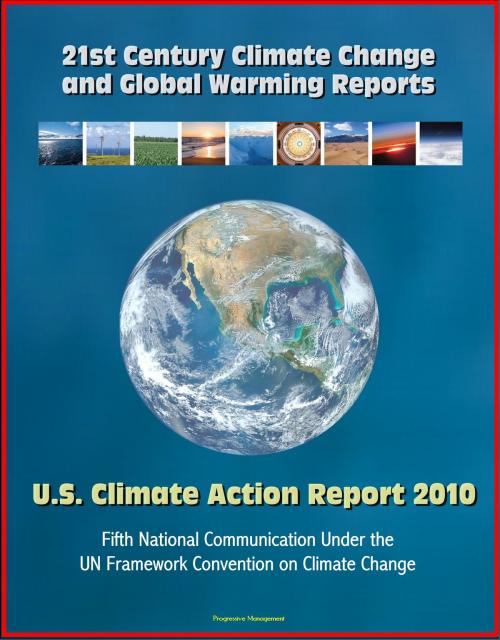21st Century Climate Change and Global Warming Reports: U.S. Climate Action Report 2010 - Fifth National Communication Under the UN Framework Convention on Climate Change
Nonfiction, Science & Nature, Science, Earth Sciences| Author: | Progressive Management | ISBN: | 9781301126194 |
| Publisher: | Progressive Management | Publication: | April 3, 2013 |
| Imprint: | Smashwords Edition | Language: | English |
| Author: | Progressive Management |
| ISBN: | 9781301126194 |
| Publisher: | Progressive Management |
| Publication: | April 3, 2013 |
| Imprint: | Smashwords Edition |
| Language: | English |
This U.S. Climate Action Report 2010 (2010 CAR) sets out the major actions the U.S. government is taking at the federal level, highlights examples of state and local actions, and outlines U.S. efforts to assist other countries' efforts to address climate change.
At the federal level, since assuming office in January 2009, President Obama has renewed the U.S. commitment to lead in combating climate change. The Obama administration, together with the U.S. Congress, has taken major steps to enhance the domestic effort to promote clean energy solutions and tackle climate change. Through the American Recovery and Reinvestment Act (ARRA), signed into law in February 2009, the United States allocated over $90 billion for investments in clean energy technologies to create green jobs, speed the transformation to a clean, diverse, and energy-independent economy, and help combat climate change. In May 2009, President Obama announced a commitment to develop the first-ever joint fuel economy and carbon dioxide (CO2) tailpipe emission standards for cars and light-duty trucks in the United States. These standards will boost fuel efficiency on average 4.3 percent annually and approximately 21.5 percent over the term of the standards, starting in 2012 and ending in 2016. In September 2009, the U.S. Environmental Protection Agency (EPA) announced its plan to collect greenhouse gas (GHG) emission estimates from facilities responsible for 82.5 percent of the GHG emissions across diverse sectors of the economy, including power generation and manufacturing.
The Earth's climate has changed throughout history. Just in the last 650,000 years there have been seven cycles of glacial advance and retreat, with the abrupt end of the last ice age about 7,000 years ago marking the beginning of the modern climate era — and of human civilization. Most of these climate changes are attributed to very small variations in Earth’s orbit that change the amount of solar energy our planet receives. The current warming trend is of particular significance because most of it is very likely human-induced and proceeding at a rate that is unprecedented in the past 1,300 years. Earth-orbiting satellites and other technological advances have enabled scientists to see the big picture, collecting many different types of information about our planet and its climate on a global scale. Studying these climate data collected over many years reveal the signals of a changing climate. Certain facts about Earth's climate are not in dispute: The heat-trapping nature of carbon dioxide and other gases was demonstrated in the mid-19th century. Increased levels of greenhouse gases must cause the Earth to warm in response. Ice cores drawn from Greenland, Antarctica, and tropical mountain glaciers show that the Earth’s climate responds to changes in solar output, in the Earth’s orbit, and in greenhouse gas levels. They also show that in the past, large changes in climate have happened very quickly, geologically-speaking: in tens of years, not in millions or even thousands.
The consequences of changing the natural atmospheric greenhouse are difficult to predict, but certain effects seem likely: On average, Earth will become warmer. Some regions may welcome warmer temperatures, but others may not. Warmer conditions will probably lead to more evaporation and precipitation overall, but individual regions will vary, some becoming wetter and others dryer. A stronger greenhouse effect will warm the oceans and partially melt glaciers and other ice, increasing sea level. Ocean water also will expand if it warms, contributing further to sea level rise.
This U.S. Climate Action Report 2010 (2010 CAR) sets out the major actions the U.S. government is taking at the federal level, highlights examples of state and local actions, and outlines U.S. efforts to assist other countries' efforts to address climate change.
At the federal level, since assuming office in January 2009, President Obama has renewed the U.S. commitment to lead in combating climate change. The Obama administration, together with the U.S. Congress, has taken major steps to enhance the domestic effort to promote clean energy solutions and tackle climate change. Through the American Recovery and Reinvestment Act (ARRA), signed into law in February 2009, the United States allocated over $90 billion for investments in clean energy technologies to create green jobs, speed the transformation to a clean, diverse, and energy-independent economy, and help combat climate change. In May 2009, President Obama announced a commitment to develop the first-ever joint fuel economy and carbon dioxide (CO2) tailpipe emission standards for cars and light-duty trucks in the United States. These standards will boost fuel efficiency on average 4.3 percent annually and approximately 21.5 percent over the term of the standards, starting in 2012 and ending in 2016. In September 2009, the U.S. Environmental Protection Agency (EPA) announced its plan to collect greenhouse gas (GHG) emission estimates from facilities responsible for 82.5 percent of the GHG emissions across diverse sectors of the economy, including power generation and manufacturing.
The Earth's climate has changed throughout history. Just in the last 650,000 years there have been seven cycles of glacial advance and retreat, with the abrupt end of the last ice age about 7,000 years ago marking the beginning of the modern climate era — and of human civilization. Most of these climate changes are attributed to very small variations in Earth’s orbit that change the amount of solar energy our planet receives. The current warming trend is of particular significance because most of it is very likely human-induced and proceeding at a rate that is unprecedented in the past 1,300 years. Earth-orbiting satellites and other technological advances have enabled scientists to see the big picture, collecting many different types of information about our planet and its climate on a global scale. Studying these climate data collected over many years reveal the signals of a changing climate. Certain facts about Earth's climate are not in dispute: The heat-trapping nature of carbon dioxide and other gases was demonstrated in the mid-19th century. Increased levels of greenhouse gases must cause the Earth to warm in response. Ice cores drawn from Greenland, Antarctica, and tropical mountain glaciers show that the Earth’s climate responds to changes in solar output, in the Earth’s orbit, and in greenhouse gas levels. They also show that in the past, large changes in climate have happened very quickly, geologically-speaking: in tens of years, not in millions or even thousands.
The consequences of changing the natural atmospheric greenhouse are difficult to predict, but certain effects seem likely: On average, Earth will become warmer. Some regions may welcome warmer temperatures, but others may not. Warmer conditions will probably lead to more evaporation and precipitation overall, but individual regions will vary, some becoming wetter and others dryer. A stronger greenhouse effect will warm the oceans and partially melt glaciers and other ice, increasing sea level. Ocean water also will expand if it warms, contributing further to sea level rise.















